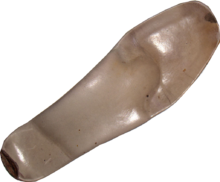Insole
Insoles are separate insoles that are placed in the shoes for reasons of comfort or for orthopedic reasons .
Normal insoles
The most common form of insole are shoe insoles, which are mass-produced industrially and offered for different shoe sizes. This type of loose inner soles is delivered together with the shoe in some types of shoes, especially sports shoes , or it can be found in shoe stores or shoemakers as an accessory for replacing worn series insoles or for additional use.
Depending on the season and intended use, the inserts can be made of different materials. Insoles used in summer are usually made of cork or rubber with a thin textile layer. Also leather and terry are used. They are usually punched and, depending on the material, sewn at the edges to prevent fraying. Since ancient times, insoles have been used in winter for better thermal insulation; classic warming insert materials are lambskin and felt , newer materials are faux fur or other synthetic materials, and heated soles are now on the market.
More and more insoles are additionally equipped with antibacterial agents, so that the decomposition of sweat by bacteria that causes the foot odor is prevented. However, possible negative health side effects of various finishing processes are discussed here. There are versions that z. B. by incorporating activated carbon , silver ions , dried herbs or by using cedar wood should avoid the odor of perspiration.
If these soles were previously produced in Europe, today production is mostly outsourced to low-wage countries . Only niche products and innovations are still produced in Europe.
Orthopedic insoles
Orthopedic insoles are individually tailored to the patient's individual foot by the orthopedic shoemaker according to the medical indication (determined by the specialist in orthopedics) , as they are intended to support the foot or compensate for incorrect posture. Depending on the country and health insurance company, the costs for this are paid or reimbursed in full or in part by the health insurance companies.
Other insoles
Three-dimensionally shaped insoles are increasingly being offered. As a rule, these products have the same characteristics: a bulky pad as a transverse arch support, an arch support for the medial edge of the sole of the foot and a recess for the heel ball, often with additional pressure-absorbing pads or inlets under the heel bone . Evidence of positive health effects of these uniform mass products on the individual feet of the wearer is still pending.
The most recent new developments in insoles also aim to have an impact on the health of the user through precise application of pressure. For this purpose, the surface consists of different hard materials at different points. For example, rivets are incorporated that exert a reflective massage effect on the soles of the feet and are intended to appeal to deep reception.
Increasingly, soles with quilted active ingredients are also being offered, which are intended to develop various health-promoting effects. So z. B. Cinnamon insoles advertised that they should naturally alleviate foot complaints such as foot sweat or cold feet. However, no evidence of effectiveness is known for this antibacterial effect or for an effective diabetes treatment. Cassiazimt unfolds its effect when taken internally or when embalming with essential oil, but no medical effect can be proven for ground cinnamon powder inside outer soles without direct skin contact.
literature
- Georgios Petsos: Orthopedic insoles and their changes depending on 1st occupation, 2nd weight, 3rd shoe size of the patient. Würzburg 1970, DNB 482147237 (Dissertation University of Würzburg, Medical Faculty 1970, 67 pages).
Individual evidence
- ^ KA Hamm, CF Carson & TV Riley: Antimicrobial activity of essential oils and other plant extracts , Journal of Applied Microbiology; Volume 86, Issue 6, June 1999, pp. 985-990
- ↑ Pamela Emmerling: Medical communication: First, heal with the word… Schattauer Verlag, 2014. ISBN 9783794529742 . (Preview p. 159 on Google Books)
- ↑ Varsha J Bansode: A review on pharmacological activities of Cinnamomum cassia Blume. In: International Journal of Green Pharmacy Volume 6, Issue 2, 2012, pp. 102-108. ( Online in the web archive )
